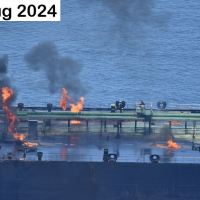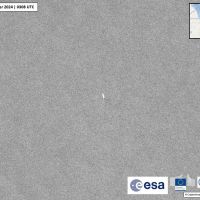NOAA Supports Response to Oil Tanker Fire in Red Sea
NOAA supported the National Response Team’s efforts to address an oil tanker presenting environmental and navigational hazards in the Red Sea.
OCT. 18, 2024 — On August 21, the Greek-flagged oil product tanker Sounion caught fire and was abandoned after being attacked by the Houthis in the southwest Red Sea. The tanker was reported to be carrying 140,000 metric tons (roughly 42 million gallons) of crude oil.
On August 23, the U.S. Coast Guard, which oversees marine pollution response, contacted NOAA’s Office of Response and Restoration (OR&R) to request expertise and scientific support for a potential oil spill response to the Sounion. OR&R worked quickly to identify environmental resources at risk in the event of a release of oil and provided a hypothetical oil spill fate and effects analysis based on seasonal weather and oceanographic trends. Additionally, NOAA’s National Environmental Satellite, Data, and Information Service (NESDIS) provided satellite imagery and analysis. Information provided by OR&R was used by the National Response Team to brief federal officials working on the incident.
After several weeks of negotiations and planning, the Sounion was successfully towed to a safer location for repairs. The fires onboard the vessel continued to burn during the towing operation. There was international concern that the large volume of crude oil on board (up to four times the amount spilled from the Exxon Valdez) could lead to a severe ecological disaster. At time of publishing, the fires aboard the Sounion were extinguished, with a potential disaster from this vessel averted.
The environmental concern associated with the Sounion was similar to the threat posed by the decaying floating storage and offloading facility Safer off Yemen’s coast in 2020, the response to which NOAA scientists supported. With about one million barrels aboard, Safer threatened an environmental and humanitarian catastrophe by risking pristine reefs, coastal mangroves, and other sea life across the Red Sea; exposing millions of people to pollution; and cutting off food, fuel, and other life-saving supplies.
Earlier in 2024, NOAA scientists from OR&R and National Centers for Coastal Ocean Science also supported the response to the 563-foot bulk carrier M/V Rubymar, which sustained damage from a Houthi missile strike in the Red Sea. NOAA determined the potential effects from an uncontrolled release of the 21,000 metric tons of ammonium phosphate sulfate fertilizer aboard the Rubymar.
more images





 An official website of the United States government.
An official website of the United States government. 






